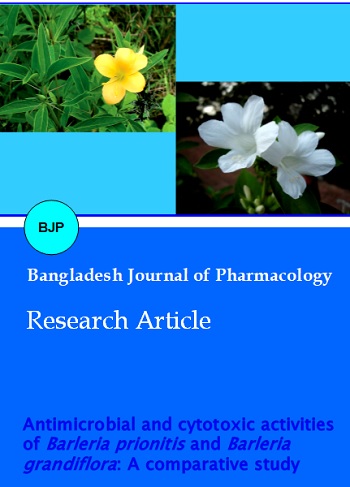Antimicrobial and cytotoxic activities of Barleria prionitis and Barleria grandiflora: A comparative study
DOI:
https://doi.org/10.3329/bjp.v11i4.27476Keywords:
Barleria prionitis, Barleria grandiflora, Antimicrobial, Minimum Inhibitory concentration, Biofilm supression, Cytotoxicity.Abstract
Leaf juices as well as leaves of Barleria prionitis and Barleria grandiflora are being used by rural people across various regions of India in the treatment of oral ailments such as dental troubles, gum ailments, pyorrhoea, dental carries and mouth ulcers. Zone of inhibition and MIC values obtained for all the extracts suggest ethanolic extract of the herbs were more antimicrobial when compared to the aqueous extract. Results of biofilm suppression were found statistically significant (p<0.05) when compared to control. Cytotoxicity was evaluated by MTT assay on human gingival fibroblast and human dermal fibroblast cell lines for ethanolic extract of the herbs. CTC50 value was found to be more than 1,000 µg/mL for ethanolic extracts of both herbs. Chlorhexidine was found to be more cytotoxic with CTC50 value of 12.525 µg/mL. Ethanolic extract of B. prionitis and B. grandiflora found significantly cytotoxic (p<0.05) in comparison with control.
Video Clip of Methodology:
Cytotoxicity assay: 18 min 45 sec Full Screen Alternative
Downloads
4740
1277 Read
1249

Published
How to Cite
Issue
Section
License
Authors who publish with this journal agree to the following terms:
- Authors retain copyright and grant the journal right of first publication with the work simultaneously licensed under a Creative Commons Attribution License that allows others to share the work with an acknowledgement of the work's authorship and initial publication in this journal.
- Authors are able to enter into separate, additional contractual arrangements for the non-exclusive distribution of the journal's published version of the work (e.g., post it to an institutional repository or publish it in a book), with an acknowledgement of its initial publication in this journal.
- Authors are permitted and encouraged to post their work online (e.g., in institutional repositories or on their website) prior to and during the submission process, as it can lead to productive exchanges, as well as earlier and greater citation of published work (See The Effect of Open Access).
